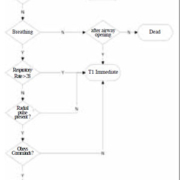Triage in mass casualty situations
More often than not major incidents and disasters result in a mass casualty situation, which places health services under added pressure. To deal with such situation it is imperative to have a Major Incident Plan both for the pre-hospital and hospital sector. The ability ‘do the most for the most’ is central to dealing with such incidents. Triage is the universally accepted tool that allows health professionals to achieve this goal in a mass casualty situation.
by Dr Wayne Smith and Prof. Lee Wallis
The incidence of major incidents and disasters has been noted to be on the increase over the last couple of decades. A recent Oxfam report highlights a four-fold increase in the occurrence of weather related disasters alone, in the last two decades [1]. Moreover, increasing urbanisation across the globe seems to contribute to an increase of major incidents [2].
Although the literature may vary on what is meant by the terms ‘major incident’ and ‘disaster’, there is no doubt as to the many challenges these pose to the delivery of healthcare.
The World Health Organization (WHO) defines a disaster as an event of such a magnitude that the normal conditions of existence are so badly disrupted and the subsequent level of suffering is of such a nature that the community is unable to respond to it.
While a disaster, by definition, overwhelms the response capacity of the community, a major incident occurs more commonly. It is defined [3] as a situation which places significant demand on the medical resources regarding the number, severity, or type of live casualties, or the location of the incident so as to warrant the response of extraordinary resources.
Many of the definitions describe an imbalance between the number of casualties and the number of resources available to treat them. Recent disasters such as the Haiti earthquake and the tsunami in Japan bear testament to the potential extent of this imbalance.
It is this imbalance – between the large number of casualties and the limited medical resources which may be available to treat them during the acute phase – that calls for extraordinary response. This could be in the form of adequate planning, testing of the plans, and education of all relevant staff that may need to respond to a major incident. Triage is one of the tools at the forefront of dealing with this large influx of casualties.
Triage
Triage is derived from the French trier, meaning ‘to sort or sieve’. In medicine, this refers to the process of sorting patients according to priority as to establish an order for treatment and evacuation. Triage can take many different forms, and operates at a number of different levels. However, the aim is to give the right patient the right care at the right time in the right place. In certain circumstances, this may also mean ‘doing the most for the most’.
Although originally developed for use in military conflicts, triage is equally applicable to civilian disasters and day-to-day emergency settings. Accurate triage allows correct identification of those patients who need the most urgent intervention, as well as identifying quickly and safely those who can wait longer for treatment. The latter is the majority at a typical major incident. Triage may also be used to identify those patients who are so severely injured that they will not survive, or whose treatment will tie up resources that would be best used with other patients.
Triage is dynamic: as the patient


